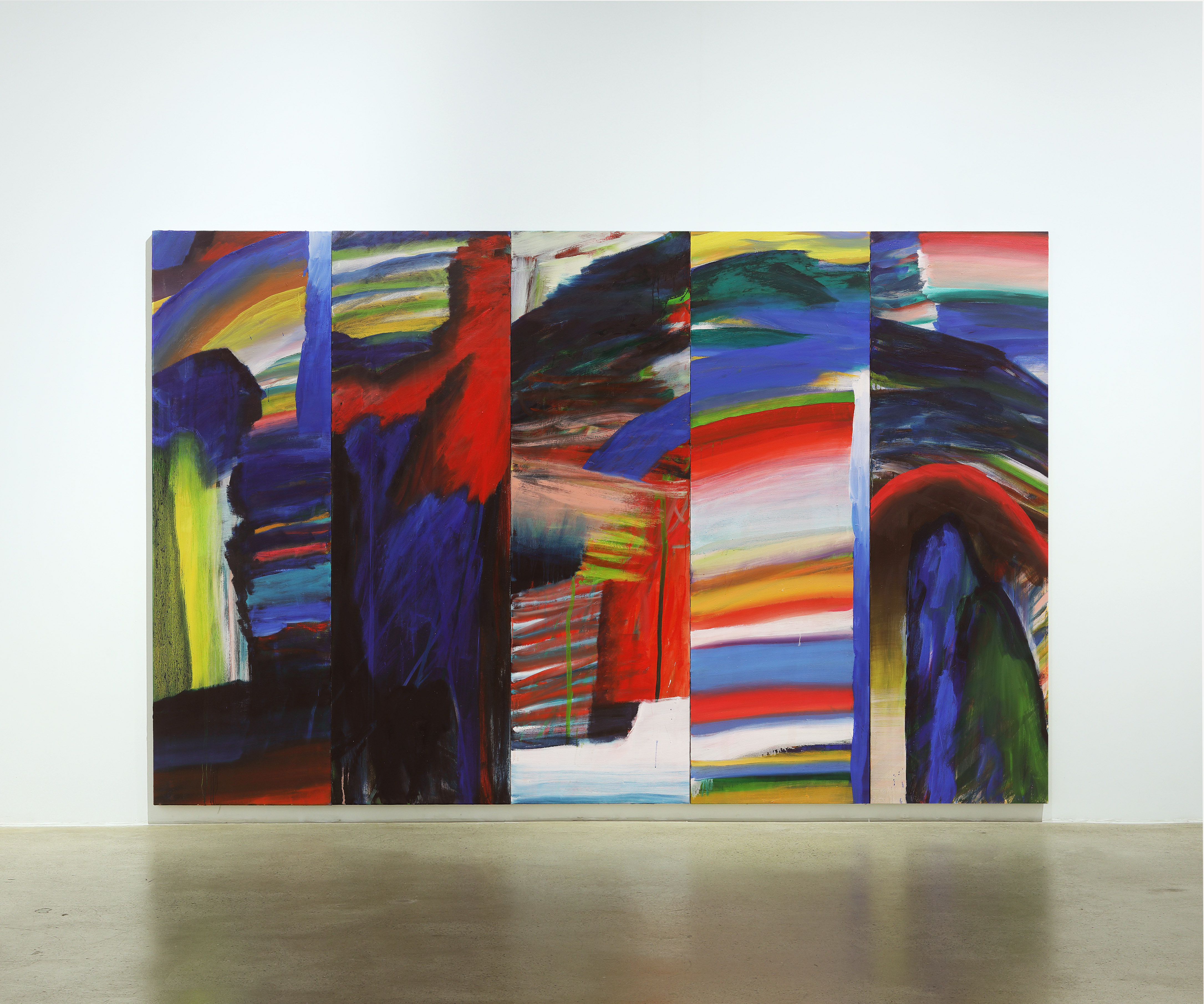
물질 구름
2022. 8.24-9.24
Art Space 3
기획: 이은주
김겨울, 김민경, 박성소영, 박현정, 박형지, 배혜윰, 성시경, 설고은, 이민정, 윤두현, 정현두, 주슬아, 한성우, 황수연
2022. 8.24-9.24
Art Space 3
기획: 이은주
김겨울, 김민경, 박성소영, 박현정, 박형지, 배혜윰, 성시경, 설고은, 이민정, 윤두현, 정현두, 주슬아, 한성우, 황수연
물질 구름
이 전시는 필자와 강석호의 공동기획으로 아트스페이스3에서 열었던 추상미술 기획전 삼부작 《이것을 보는 사람도 그것을 생각한다》(2019), 《당신의 삶은 추상적이다》(2019), 《정보의 하늘에 가상의 그림자가 비추다》(2020)의 참여 작가 14명의 최근작을 보여주기 위해 기획되었다. 첫 전시가 열린지 햇수로 3년이 되었으니 그간 작가들의 삶에도 작업에도 변화가 있었을 것이다.
그 방법론은 제각기 다르지만, 이 작가들은 모두 지금 이곳에 있는 몸과 질료를 도구로 하여 비가시적이고 추상적인 세계를 형식화하고 있다. 내적 충동을 색채로서 표현하거나, 순수조형 요소들간의 이상적 관계를 포착하거나, 실존적 몸을 투영했던 과거의 역사적 추상의 태도들은 이들에게 있어 이미 학습된 디폴트 값이다. 여기에 덧붙여진 것은 소소한 일상적 경험에 대한 감각(김겨울, 김민경, 박형지)과 우주적 차원에 대한 동시대적 관심(박성소영), 디지털 미디어 환경 속에서의 물질에 대한 반응(박현정, 설고은, 윤두현, 주슬아)이다. 어디에도 없는 형태를 창조하는 조형적 사고의 과정(배헤윰, 이민정, 황수연)이나 지시 대상이 없는 세계를 그린다는 것에 대한 문제(성시경, 정현두, 한성우)는 여전히 유효한 화두이다.
탈모더니즘의 맥락 속에서 한동안 자취를 감추었던 ‘조형’ 그 자체를 중시하는 태도는 2010년대 이후 다시금 주목할 만한 현상으로 나타났다. 2000년대의 한국 작가들이 과다해진 거대담론과 사회적 현상에 대한 집단적 관심을 비워낸 공백을 일상적 관찰과 감흥으로 채워나갔다면, 2010년대 이후의 보다 젊은 많은 작가들은 외부의 현상보다 그들 내부 안에서 일어나는 사건들에 주목하고, 지시하는 것과 지시된 것 사이의 관계를 더욱 느슨하게 만든 한 상태에서 순수 조형요소들을 가지고 그들의 사고, 감각, 상상을 조형화하고 있다.
이 전시를 통해 구름처럼 붙잡기 어려운 상태로 존재하고 있는 비가시적인 것들을 쫓는 이 작가들의 여정을 따라가보았으면 한다. 이들은 언어와 이미지 사이의 공백을 의도적으로 더 넓히면서, 현실의 표면에 물질을 매개로 아주 약간의 발을 딛고 서 있다.
흔히 ‘뜬 구름 잡는다’는 말을 한다. 애매하고 추상적인 이야기를 하는 이들, 비현실적인 몽상가들을 빗대어 하는 말이다. 그러나 구름도 엄연히 실체가 있는 물질이다. 과학적 정의에 의하면, 구름은 너무 가벼워 상승기류에 의해 대기에 떠 있는 아주 작은 물방울들이나 얼음 결정들의 모임이다. 물질이되 땅에 구속되지 않는다니 너무나 아름답지 않은가!
액체와 고체와 기체 사이에 있는 이 모호한 물질의 상태는 바로 그 모호함 때문에 어디로나 갈 수 있는 자유로움에 대한 메타포이자 시적 상상력의 원천이 되었다. 우리에게는 분명한 것들을 지시하지 않는 이미지가 주는 상상의 여백이 필요하다. 뜬 구름을 바라보며 잠시 딴 생각을 하는 시간이 필요한 것처럼.
“이 세상에서 구름보다 더 아름다운 것이 있다면 보여달라. 구름은 놀이이고 세상에서 가장 아름다운 값진 것이다”
헤르만 헤세, 페터 카멘친트 중
구름처럼 있을 강석호를 생각하며
이은주

Cloud Matter
This exhibition was designed to show the latest works of the 14 participating artists in the Artspace3 abstract art exhibition trilogy "One Seeing This Also Thinks That" (2019), "Your Life Is Abstraction" (2019), and "Virtual Shadow Casts on the Sky of Data Interface" (2020), that were under the joint planning of Kang Seok-ho and me. It has already been three years since the first exhibition was held, so there must have been changes in the lives and works of the artists.
Each methodology is different, but all of these writers are formalizing an invisible and abstract world using the body and matter as tools that are present here and now. For them, expressing inner impulse as colors, capturing ideal relationships between pure sculpture elements, or past historical abstract attitudes that projected an existential body are the default values that have already been learned. Added to this is the sense of small everyday experiences (Kim Winter Gyeoul, Kim Minkyung, Park Hyungji), contemporary interest in the cosmic dimension (Park So young), and the response to matter in the digital media environment (Park Hyunjung, Seol Gwen, Yoon Doohyun, Joo Sla). The process of formative thinking that creates a form that is nowhere (Bä Hejum, Lee Min Jung, Hwang Sue Yon) or the problem of drawing a world without an object of instruction (Sung Sikyung, Jung Hyun-doo, Han Sungwoo) is still a valid topic.
The attitude that emphasizes the aesthetics of plastic art itself, which faded into the background within the context of postmodernism, has emerged anew as a remarkable phenomenon since the 2010s. While Korean artists in the 2000s filled the vacancy that emptied overheated metadiscourse with daily observation and inspiration, since the 2010s many younger Korean artists have been paying more attention to events happening in themselves than to external phenomena, and are shaping their thoughts, senses, and imaginations with pure formative elements in a state that has loosened the relationship between what does the referring and what is referred to.
Through this exhibition, I hope one follows the artists' journey of chasing invisible things that exist in a state like clouds that clearly have physical reality but are intangible. They step lightly on the surface of reality through matter, intentionally widening the gap between language and image.
It is often said that one is trying to catch a floating cloud. It is a metaphor for those who tell vague and abstract stories unrealistic dreamers. However, clouds ― are also physical matter that is clearly real. By scientific definition, clouds are a collection of tiny droplets or ice crystals floating in the atmosphere by rising air currents because they are so light. Isn't it so beautiful to be matter that is not bound to the ground? The ambiguous state of matter at the boundary between water, ice and vapor become a metaphor for freedom to go anywhere and a source of poetic imagination because of its ambiguity. We need an imaginary margin from an image that doesn't refer to obvious things. Just like we need a moment to look at the clouds and let our minds wander.
"If there is anything more beautiful than clouds in the world, show me. Clouds are a plaything and the most beautiful, priceless thing in the world." Herman Hesse, Peter Camenzind
In memory of Kang Seok Ho.
May he remain like a cloud,
Lee Eunju